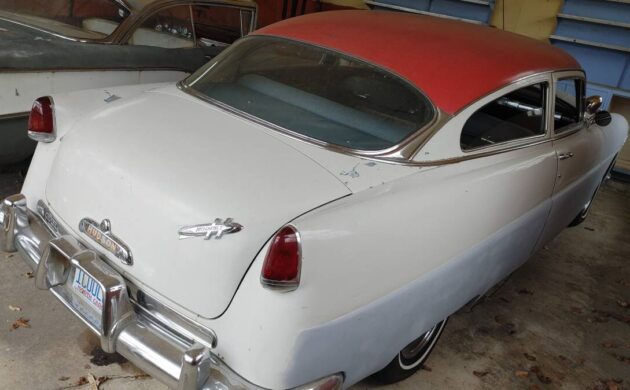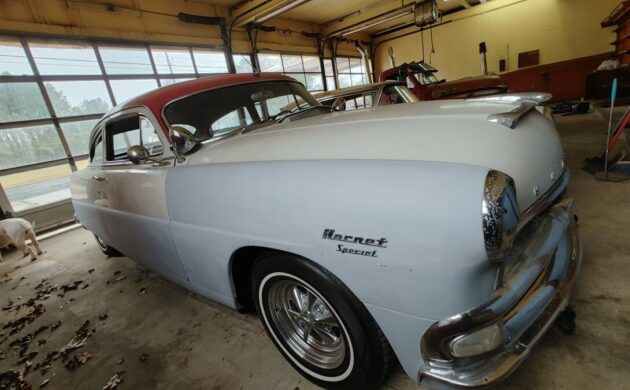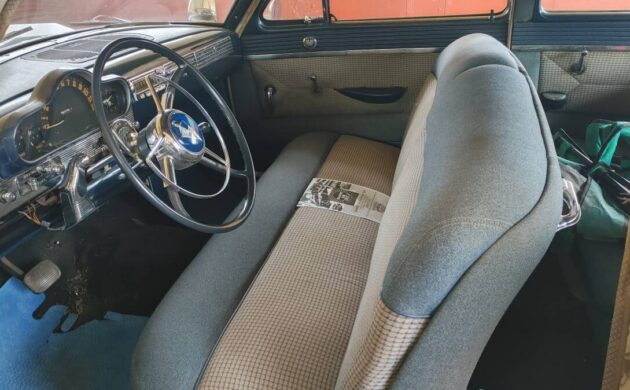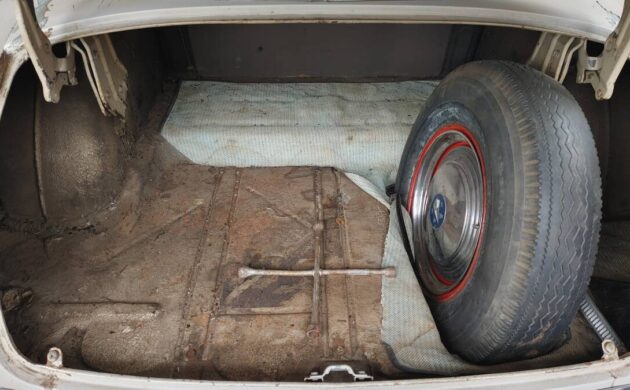When racing resumed in the United States after World War II, the concept of stock car racing according to the gospel of Big Bill France slowly gained speed in the South. One of the first cars to become a consistent winner was the Hudson Hornet. From 1952 through the end in 1954, Hornets dominated NASCAR only to basically disappear after the Nash merger. If you want a glimpse of what it was like to drive an early NASCAR “stock car,” then take a look at this 1954 Hudson Hornet Special for sale on craigslist somewhere in swampy Eastern North Carolina. At an asking price of $12,500, is this mostly original Hornet a project you would like to get across the finish line? Thanks to T.J. for the interesting tip!
The story of the rise of NASCAR has been told repeatedly, but one thing that historians don’t focus on was that the organization was comprised with a motley cast of characters. Big Bill was a gas station owner and part time mechanic with huge aspirations and a knack for organizing. NASCAR’s first champion, Red Byron, was a handicapped World War II vet who was backed by Raymond Parks. Parks, who also loaned money to France and helped keep the organization afloat, was an otherwise decent fellow who made boatloads of money with his gaming machines and illegal booze in the city of Atlanta. Parks was the car owner, and his later list of Dawsonville, Georgia based drivers were all moonshine runners. The list of drivers, owners, and mechanics could go on and on, but nearly all would be from the working class, and many were difficult to manage on a good day. The constant availability of alcohol was a factor.
One of the hardest for France to control was Henry “Smokey” Yunick. Smokey was a B-17 and B-24 pilot during the war who ended up in Daytona Beach, Florida after the war. It was there that he became friendly with local driver Marshall Teague. Teague had already started his driving career with a little help from Pure Oil and what could generously be called factory help from the Hudson Motor Company. Teague was far more ambitious than his time allowed, and he ended up managing a second team with Herb Thomas as the driver and Smokey as the mechanic.
It wasn’t long before Teague ran afoul of Big Bill and his luck was on the wane. In contrast, the combination of Hudson’s step-down body design, Thomas’s incredible hand-eye coordination, and Smokey’s innate ability to find ways to make horsepower led to the team winning races in a dominant fashion. Big Bill’s attention was soon focused on Yunick, who looked at a rule book differently than others. In his eyes, if something wasn’t expressly forbidden, it was fair game. With his Hudson Hornets winning on a regular basis, there was a constant cat and mouse game between him and NASCAR where rules were concerned. This devolved into a feud that some feel lasts to this day. While most NASCAR scholars agree that Smokey Yunick should be enshrined in the NASCAR Hall of Fame, that may never happen. The decades old antagonistic relationship, his self-published autobiography (complete with highly critical and somewhat offensive comments inside about Big Bill, Bill Jr., and Brian France) may be too much to overcome.
What cannot be buried is the winning record that the Hudson Hornet racked up in the period it was the dominant car in the series. In 1952, Herb Thomas and a handful of other Hornet drivers won 27 races. 1953 saw 22 wins, and 1954’s total was 17. Thomas and Yunick won the NASCAR championship in 1951 and 1953 and were second in 1952 and 1954. By that time, the new V-8 engines and more modern designs were narrowing the gap. That year, Hudson was swallowed up by Nash-Kelvinator. The once proud nameplate soon became a badge engineered version of a Nash, and the racing party was over for Hudson. Meanwhile, the rolling soap opera that was NASCAR moved on. The Fabulous Hudson Hornet, which was emblazoned on many of these Hudson race cars, miraculously made a comeback in the Pixar animated movie “Cars.” With the introduction of the character of “Doc Hudson” (voiced by race car driver and occasional actor Paul Newman), a whole new generation of fans were given a glimpse of NASCAR’s early days.
The somewhat fabulous Hudson Hornet you see here is a desirable 1954 model in mostly original condition. There has been some bodywork and primer added to the original paint, and the set of Cragar wheels and whitewall tires are a bit out of place. The good news is that the seller has the factory wheels, and the rest of the car is basically as it left the Detroit. Believe it or not, these cars also had fender skirts to further close up the already narrow wheel opening in the quarter panels. One of the complaints from racers was that when one of the fragile rear axles broke, the tire had no place to go. As a result, the now loose tire would propel the rear end of the car up “ass over teakettle” (as Yunick described it) and flip the car over. NASCAR rules at the time mandated that rear ends and most everything else were to remain stock. The purpose-built race car you see in NASCAR today is a far cry from the “stock cars” of yesterday.
Under the hood is a copy of the famous Hudson inline six-cylinder engine that powered so many of these cars to victory. This engine does not feature the famous “Twin-H Power” dual carburetor setup but is said that all 308 cubic inches run great. In fact, the seller attests to having driven this Hornet recently on a four-hour trip at highway speeds. The claim is made that a drive to California would not be out of the question in this car.
In all, this would make a great project. The interior is original, and in good condition. A repaint and returning the removed parts to their proper places would go a long way towards making this a very presentable and useable automobile. Automotive technology was moving fast in the early 1950s, and racing did drive Hudson development. This is a fairly rare car with a very important place in history. Hopefully it finds a good home with someone who will share its story and how it was an integral part of NASCAR history.









Whew,,NASCAR aside, it’s okay, the author clearly passionate about NASCAR, but more accurately, Hudson was just a DAMN( hey, Jeff said “ass”) nice car. The “step down” interior, the factory “chopped top”, while the “twin H”( which I never saw in the real world, btw) and it’s racing heritage was noteworthy, it was the last gasp for the great automaker, as V8s put the Hudson to rest.
For folks that don’t know, or care, about it’s racing history, it’s a really nice find. Mags, spots, the automatic, I think Hydra-Matic, THIS, in any circle, would be the epitome of the classic car, even though, most never saw a Hudson, or a Packard, or a Nash, or a Kaiser,,,,
Just found a Packardbaker sitting at a local garage here in nw Pittsburgh recently!
Great write up Jeff. Racing of all kinds was just getting spooled up to higher levels and folks like Smokey Yunick really made it pop. The Garlit’s museum in Ocala, Florida has a corner with some of Yunick’s tools out of his shop on display. There are a couple of publications that are well worth reading about the man and his machines and his ability to stay one step ahead of the rules of the day. The real kicker for me was his using the roll cage as a gas tank to increase the car’s range. Nice looking car here. Really needs that new paint job to set it off properly.
No “Twin H-Power” — and thus, certainly no “7X,” no NASCAR.
bobhess mentions Smokey Yunick and, from what I’ve heard over the years, he was one of the first — maybe THE first outside Hudson — to pull more suds out of that big “six.” Read “The Best Damn Garage in Town” (not the easiest book to get through, but worth it for Smokey/NASCAR fans) for a colorful look at Yunick’s early days in Daytona.
My “dream” Hornet would be a two-door like this, with the four-speed hydro behind a Twin H-Power 308, riding on steelies. Herb Thomas/Yunick paint job optional.
I have an old issue of Stock Car Racing magazine that
has an article on Yunick.I was excited to see that his favorite
car was a Ford Fiesta.
Back when NASCAR was “real”.
Nice write up and homage to one of the greatest wrenches that ever tore into a car. He did amazing things with engines and did keep the rule writers on their toes. For a guy with limited education what he accomplished was no less than amazing. A self taught genius.
This Hudson looks so different without all of the ‘heavy’ looking trim. I love the look – both ways. The car now, from the back, reminds me of a chopped and channeled ’54 Ford.
One could run it as it is until your ready for the next step – if you even decide to take that journey.
I read somewhere years ago about how they got the Hudson motor to run backwards to help engine tourqe plant the left front down to corner better, they had to flip the rear over to get the wheels turning in the right direction. No idea where I read it so maybe I am imagining it
Hi Timothy, no, you aren’t imagining it, about a year ago, BFs featured another Hudson, and you asked the same thing. It was Smokey Yunick that ran an Offy 4 cylinder backwards. Can’t find anything on a Hudson stock car tho,
No, you read right. I saw it in a series on Smokey in Popular Hot Rodding. He ground a special cam for it and when confronted by NASCAR he slammed it on the floor and destroyed it. “I wasn’t cheatin’, I was just being competitive!”
I had an aunt/uncle in Wichita Falls, Tx that always drove a Hudson. It was big & beautiful.
My future wife bought a big 4 door in about 1960 from an uncle for about $200. What a boat. I think it used that much oil in the next 2 years.
This a Hornet “Special” which is a cheaper stripped down model they hoped would spur sales in a down year and is the only Hornet ever made in the Brougham body style ( 2dr with the long 4dr roofline) Its a pretty rare find. Stepdowns were unibodies with a front subframe and you need to be careful about rust especially in the rockers and around the rear wheelwells. On 48-53 stepdowns the rockers and qtrs were bolt-on so rust repair is a lot easier than the all welded bodies of the 54. Because of the primer in these areas I would expect that the car has had rust repair, as most eastcoast stepdowns have. The real challenge is getting the rocker to match the front to back curve under the door and recreating the wheel lip opening so that the skirts can be installed. Its seldom accomplished without a lot of bondo. On the plus side 54s used a lot more stainless than the diecast heavy 51-3 Hornets so the plating bill is a fraction of the earlier models. Its fairly doable to clone the 7X engine and is still frequently done though not inexpensive. Best handling car of the era and fully capable on the interstate. Great cars and the club is by far the best of the many I have been in or around!
The problem with all the guys who do Hudsons up with a”7X’ is that the 7X was more than a more powerful 308 engine. The full 7X package for racing included: heavier suspension., heavier rear axles and real end, a 25 gallon fuel tank vs. standard 20 gal. and a few other mods. A true 7X package is a very rough ride for a street vehicle. VERY few full 7X packages still survive. The 1954 Hornet Special was the only year in the stepdown era that Hornet could be purchased as a brougham.
Wow! A step down Hornet for a decent price. And it doesn’t look too bad in the pics. This will sell, quick.
Before I bought it in 1966, for $300, the previous owner had transplanted a Hudson 308 with Twin H Power into a ’39 MG SA, which was a big car, 119 inch wheelbase, sat 4, originally had a 6, so it fit, sort of, the firewall had to be cut to make room for the end of the overdrive transmission, and the shifter had no gates, so you shifted by feel. It had far more power than the MG engine it replaced, and I feared overpowering the rear axels, or the wire wheels, but never did. Hudson parts being scare even in 1972 when I sold it, I contemplated putting in a MOPAR slant 6, would fit, lighter, and not as powerful as the Hudson, but a lot easier to get parts, and powerful enough. Now, with the internet, I find that although MG built only 500 of these before WWII ended production, Wolesley (sp?) used the same engine in its police cars in the ’30’s and there were more than 10,000 produced, so today, it could be fixed or replaced.
Before I bought it in 1966, for $300, the previous owner had transplanted a Hudson 308 with Twin H Power into a ’39 MG SA, which was a big car, 119 inch wheelbase, sat 4, originally had a 6, so it fit, sort of, the firewall had to be cut to make room for the end of the overdrive transmission, and the shifter had no gates, so you shifted by feel. It had far more power than the MG engine it replaced, and I feared overpowering the rear axels, or the wire wheels, but never did. Hudson parts being scare even in 1972 when I sold it, I contemplated putting in a MOPAR slant 6, would fit, lighter, and not as powerful as the Hudson, but a lot easier to get parts, and powerful enough. Now, with the internet, I find that although MG built only 500 of these before WWII ended production, Wolesley (sp?) used the same engine in its police cars in the ’30’s and there were more than 10,000 produced, so today, it could be fixed or replaced.
Y were these cars so beloved, I am not from the era so have nostalgia for something different. Is that the only explanation? Or the orphan status? The design boost (step-dwn frame). Looks like a ford shoe box some, eh? May B all of these?
I like a bent8 flattie, this car’s “lines”, its huge 5L (as i6, i8 is my fav motor) six cyl and 2v carb (or 2 carbs).
I actually purchased this Hudson! Cool
To find an article on it!